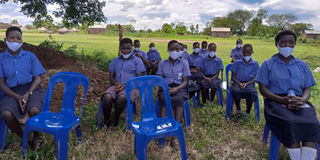No learner should be left behind

Primary Seven candidates of Atopi Primary School, Apac Municipality, at an assembly after reporting to school on October 15. PHOTO | BILL OKETCH
What you need to know:
- The issue: Schools reopening
- Our view: ... it is important that a plan to ensure no learner in candidate class is left behind is urgently put in place.
Last week, candidate classes and finalists in higher learning institutions resumed classes following the closure of schools in March as a measure to contain the spread of Covid-19.
Many schools however registered low turn-up due to various reasons, many of which have been earlier highlighted by schools following the release of the Standard Operating Procedures (SOPs) they are expected to implement.
There are requirements each school must possess before being given compliance certificates such as having adequate furniture arranged for social distancing, isolation rooms, hand washing facilities at all strategic places, restricted access and exit to school and availability of disinfectants, among others.
Many schools met these requirements to reopen. However, challenges remain, especially for the urban day schools where the SOPs require learners and teachers not to use public transport on any occasion. Schools are, therefore, required to organise dedicated vans/buses to transport learners.
These SOPs, though well intentioned, present huge challenges for parents and schools. As noted last week through a survey by this newspaper, only few students had been cleared to begin classes in many schools across the country.
In one of the schools – St Barnabas Primary School, Muyenga – only two candidates out of 57 reported to school on opening day. This is not a good indicator given the already high drop-out rates.
Recent data from the national examination body indicates that only 20 per cent of the pupils who sit PLE reach Senior Six. Even if some students joined vocational /technical institutes along the way, such institutions do not have the capacity to absorb the number of students who do not reach A-Level, according to UNEB.
This echoes earlier surveys on school dropouts. In 2005, the Overseas Development Institute, a UK-based think tank, released a report that highlights the rate of school dropouts under UPE. The report shows that of the 2,159,850 pupils that were enrolled in Primary One in 1997 – the year UPE was introduced – only 485,703 reached Primary Seven in 2003.
It further notes that while more than one million pupils enrolled in UPE in 2006, only 463,332 of the 1,598,636 sat for Primary Leaving Examinations (PLE) seven years later.
This trend has been a major concern and with the disruptions brought about by the Covid-19 pandemic, the country is likely to register huge drop-out rates.
Reasons for learners failing to return to school are diverse but it is important that a plan to ensure no learner in candidate class is left behind is urgently put in place.
There is a short time for final year students to prepare for examinations. It would be unfortunate for learners to drop out at this stage.




